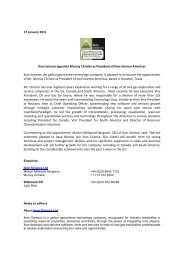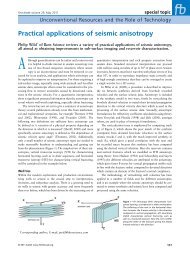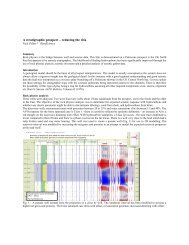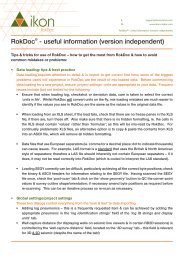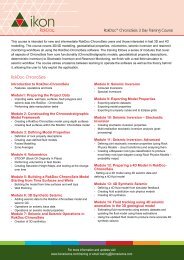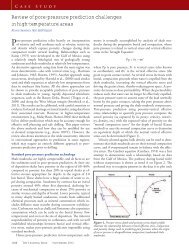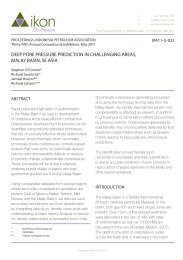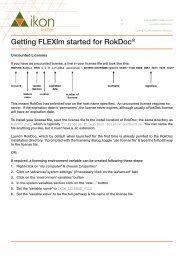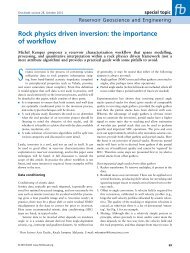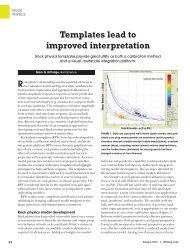Using VSP Data to Determine Anisotropy - Ikon Science
Using VSP Data to Determine Anisotropy - Ikon Science
Using VSP Data to Determine Anisotropy - Ikon Science
You also want an ePaper? Increase the reach of your titles
YUMPU automatically turns print PDFs into web optimized ePapers that Google loves.
<strong>Using</strong> <strong>VSP</strong> <strong>Data</strong> <strong>to</strong><strong>Determine</strong> <strong>Anisotropy</strong>- with RokDoc-<strong>VSP</strong> and RokDoc-anisotropymodules.Phil Wild<strong>Ikon</strong> <strong>Science</strong>EAGE – Amsterdam 2009
Talk Outline• Discussion of the anisotropies that we might encounter• <strong>VSP</strong> configurations• Travel time inversions: Walk-away, away, walk-aroundaround• Shear waves: multi-component<strong>VSP</strong>s• Inverting the <strong>VSP</strong> data for anisotropy• Overburden• Fracture anisotropy• Acquisition design• Live demo using RokDoc - <strong>VSP</strong>
Seismic <strong>Anisotropy</strong>• VTI - Overburden anisotropy• For example, fromhorizontally layered shales.XSymmetryaxis• Vp vertical < VpZYVp horizontalVTI• HTI – e.g. Vertical fractures• Such as in sands<strong>to</strong>ne orcarbonate reservoirsXSymmetryaxisZYHTI• Azimuthal velocity variation• Shear-wave splitting©EAP
How might we measure it?Labora<strong>to</strong>ryBorehole<strong>VSP</strong>Walk-AwayFMIShear-wavesplittingDipoleSonic
Shot and receiverlocationsWalk-Away <strong>VSP</strong>ReceiverGatherShotGatherHodograms
Inverting data from the overburden1. Compute vertical andhorizontal slownessesCommon shot gather: verticalslowness (q) computed fromwave arrival travel time picks(Δt/ t/Δdepth) depth).2. Invert for ThomsenparametersCommon receiver gather:horizontal slowness (p)computed from wave arrivaltravel time picks (Δt/(t/Δoffset) offset).3. Repeat over a range ofdepth locations
Multi-component <strong>VSP</strong>1. Use P-arrivals P<strong>to</strong>rotate data in<strong>to</strong>radial andtransversedirections.2. Identify shear-waves (bymoveout andsplitting).3. Rotation andtime-shift of splitshear-wavesallows data fromthe 2 components<strong>to</strong> be overlain.
Interpretation of Fracture Direction1. Fast and slowshear directionsfrom thehodogram.North3. Confirmation ofshear-wavedirection fromborehole image.TSlowshearShotpointWellheadReceiver <strong>to</strong> shot offset: 150mReceiver <strong>to</strong> shot azimuth: 258°R2. Registration ofshear-wavedirection withrespect <strong>to</strong> theacquisition.Fastshear
Acquisition Design for Fracture Imaging• For a <strong>VSP</strong> we want sufficient offset for P <strong>to</strong> Shear conversion and d forgeophone alignment.• Beyond <strong>VSP</strong>s, , e.g. OBC, there are two rules of thumb relating <strong>to</strong> theuse of seismic data <strong>to</strong> image fractures:• 1. Certain azimuthal directions give a stronger AVO responsethan others.• 2. In general, a reflected shear-wave has a larger amplitudechange in the presence of fractures than a corresponding P-Pwave.
Acquisition Design for Fracture ImagingThree steps <strong>to</strong> acquisition design for imaging fractures:1. Use existing fracture information(e.g. from FMI logs or <strong>VSP</strong>s) ) <strong>to</strong> selectanisotropic zones. Assign anisotropicparameters <strong>to</strong> the zones based onlabora<strong>to</strong>ry data, empirical relationshipsor fracture compliances.2. Blocky modelling <strong>to</strong> investigateAVO trends, here showing PSv andPSh diffferences and an angulardependence.3. Syntheticseismograms showdifferencesbetween the signalwith and withoutfractures (shadedzones in the plot).Offset
Talk Outline• Discussion of the anisotropies that we might encounter• <strong>VSP</strong> configurations• Travel time inversions: walk-away, away, walk-aroundaround• Shear waves: near offset• Inverting the <strong>VSP</strong> data for anisotropy• Near surface• Fracture anisotropy• Acquisition design• Live demo using RokDoc - <strong>VSP</strong>



